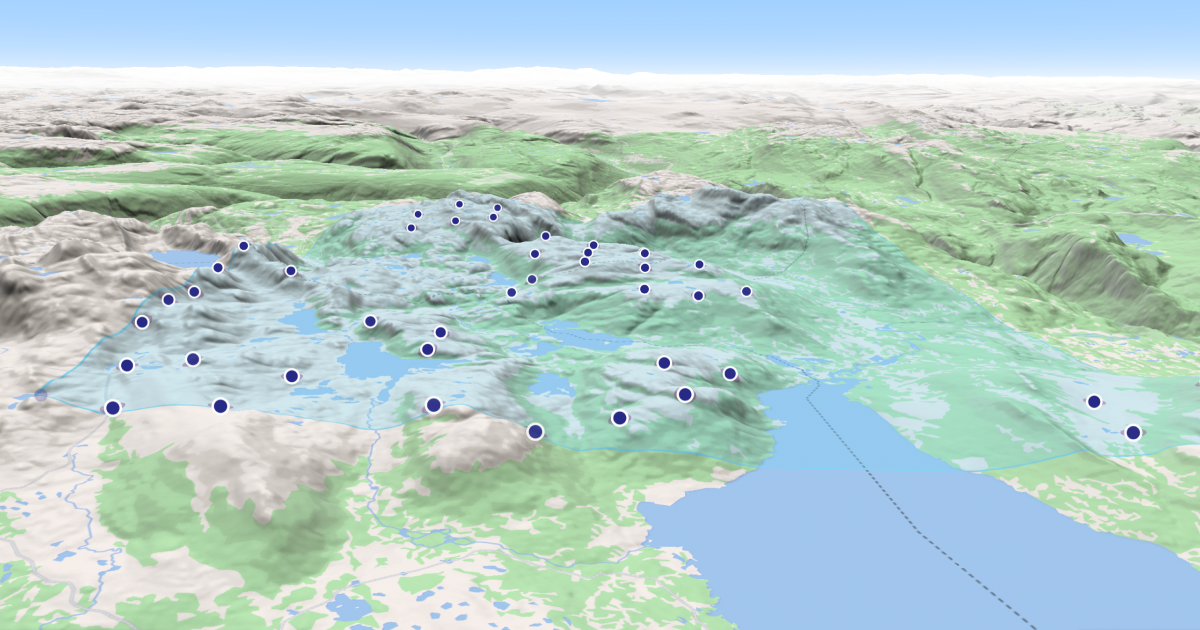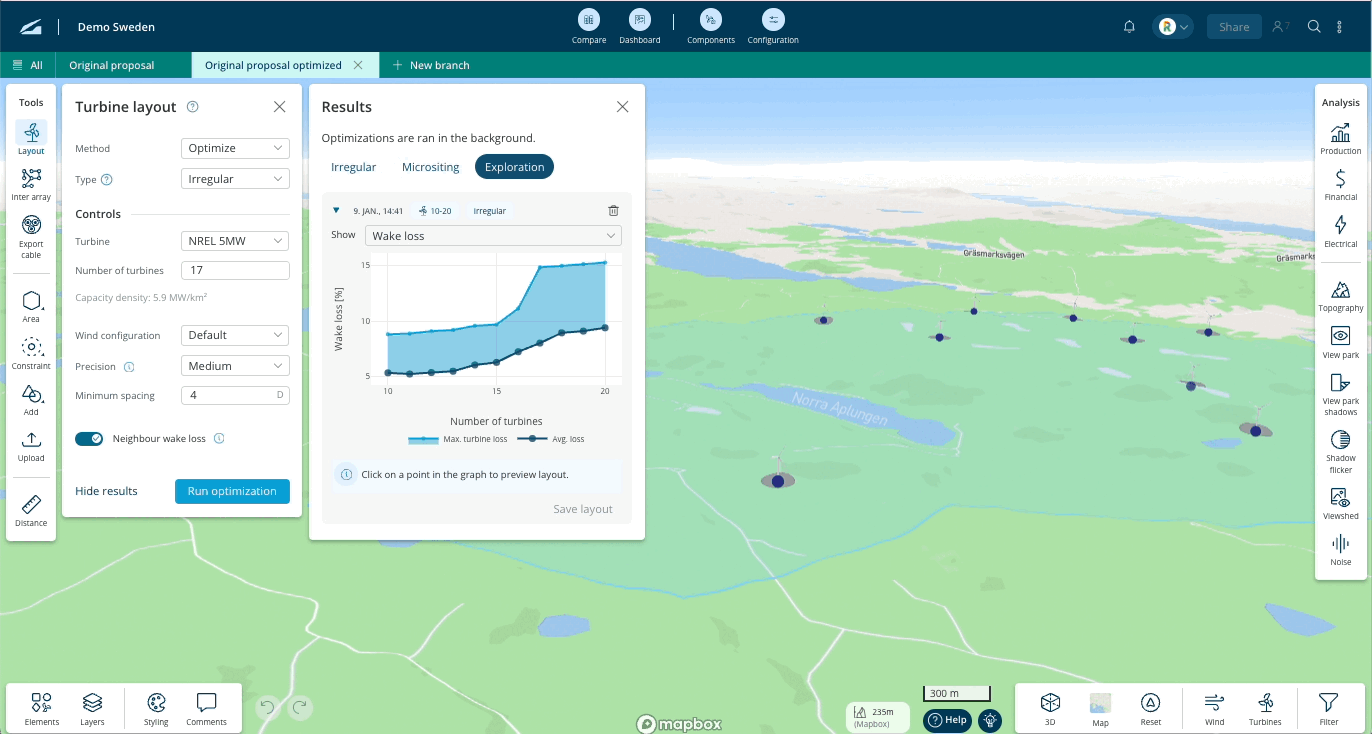The Vind AI optimisation engine optimises layouts in minutes. With a wide range of layout optimisation options ready to go, you can optimise turbine positions to maximise expected annual energy production (AEP) or minimise levelised cost of energy (LCoE). The fast optimisation mode is ideal for quickly obtaining layouts for early business cases.

Use your custom turbine specifications, analysis settings and wind data for layout optimisations that are perfectly tailored to your site and project.
Vind AI includes a range of optimisation methods so you can find the optimal turbine layout for many different types of sites and projects. Our optimisation engine supports optimising wind turbine layout for:
You can easily compare the results for key parameters of different optimisations, to find the overall best wind turbine layout.

Regular wind turbine layouts are common in offshore wind projects. In Vind AI you may choose to constrain the optimisation to always put the wind turbines in regular grids, and the optimiser will find the optimal grid orientation, axes spacing and row offsets.
Improve existing wind turbine layout with our Micrositing tool. By moving all turbines individually and incrementally, find a layout with the same design characteristics as the original one but with improved annual energy production (AEP).
By modelling wind turbine layout, foundations, and the electrical system in the same tool, you can immediately see what effect a change in the wind turbine layout has on the electrical system in terms of losses or financial performance.

With an increasingly crowded seabed and land area, accounting for complex site constraints is essential. In Vind AI, you can make sure your turbine optimisations exclude areas that are off-limits due to environmental concerns or distance rules, or that are non-buildable due to practical factors like steepness. The optimisations can also account for noise constraints or height constraints.
A wind turbine layout optimisation in Vind AI completes in minutes. You can easily start multiple wind turbine layout optimisations at once and let them run simultaneously—and even better, they can run in the cloud, leaving you (and your computer power) free to do other things in the meantime.
Even for large wind farms, you can model your wind project site as it truly is, accounting for real-world wind variations, complex site constraints, and thousands of design variables, without cutting any corners to make the computation work.
The speed and ease of the optimisations mean you can easily run many wind turbine layout iterations as you progress your project—and in Vind AI, it’s super simple to compare scenarios.
A wind turbine layout optimisation in Vind AI completes in minutes. You can easily start multiple wind turbine layout optimisations at once and let them run simultaneously—and even better, they can run in the cloud, leaving you (and your computer power) free to do other things in the meantime.
Even for large wind farms, you can model your wind project site as it truly is, accounting for real-world wind variations, complex site constraints, and thousands of design variables, without cutting any corners to make the computation work.
The speed and ease of the optimisations mean you can easily run many wind turbine layout iterations as you progress your project—and in Vind AI, it’s super simple to compare scenarios.
In Vind AI, you can co-optimise layouts and electrical systems, seeing both the energy and financial implications of any changes to a wind turbine layout
A wind turbine layout optimisation in Vind AI completes in minutes. You can easily start multiple wind turbine layout optimisations at once and let them run simultaneously—and even better, they can run in the cloud, leaving you (and your computer power) free to do other things in the meantime.
Even for large wind farms, you can model your wind project site as it truly is, accounting for real-world wind variations, complex site constraints, and thousands of design variables, without cutting any corners to make the computation work.
The speed and ease of the optimisations mean you can easily run many wind turbine layout iterations as you progress your project—and in Vind AI, it’s super simple to compare scenarios.
In Vind AI, you can co-optimise layouts and electrical systems, seeing both the energy and financial implications of any changes to a wind turbine layout
The Vind AI optimisation engine uses a combination of state-of-the-art optimisation techniques and innovative analysis methods. Want to learn more about exactly how our optimisation engine works? Read the blog ‘Increasing complexity of wind farm design demands new optimisation methods’ from our Senior Algorithm Engineer, John Marius Hegseth.
A wind turbine layout optimisation in Vind AI completes in minutes. You can easily start multiple wind turbine layout optimisations at once and let them run simultaneously—and even better, they can run in the cloud, leaving you (and your computer power) free to do other things in the meantime.
Even for large wind farms, you can model your wind project site as it truly is, accounting for real-world wind variations, complex site constraints, and thousands of design variables, without cutting any corners to make the computation work.
The speed and ease of the optimisations mean you can easily run many wind turbine layout iterations as you progress your project—and in Vind AI, it’s super simple to compare scenarios.
In Vind AI, you can co-optimise layouts and electrical systems, seeing both the energy and financial implications of any changes to a wind turbine layout
The Vind AI optimisation engine uses a combination of state-of-the-art optimisation techniques and innovative analysis methods. Want to learn more about exactly how our optimisation engine works? Read the blog ‘Increasing complexity of wind farm design demands new optimisation methods’ from our Senior Algorithm Engineer, John Marius Hegseth.
We believe that a digital platform should never be a black box for the user. In our ‘Trust Centre’, we share detailed documentation of how our optimisation models work, and how our results hold up compared to trusted tools, methods and real-world data.